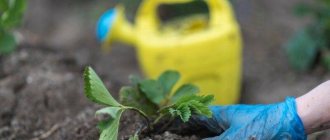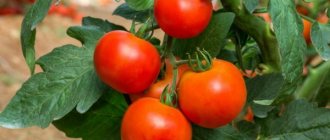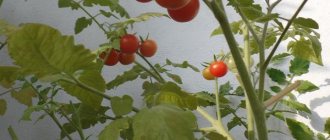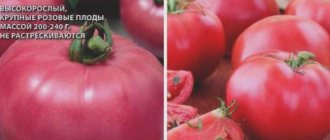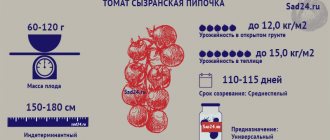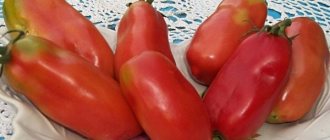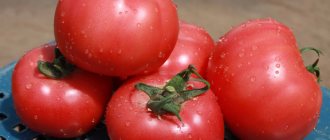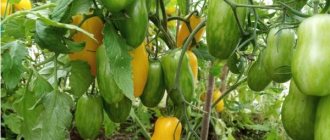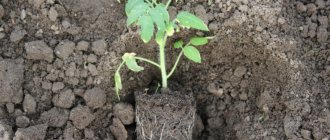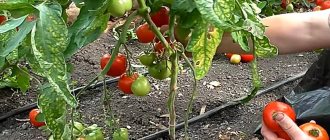Gardeners like the Fat Monk tomato because it does not require much time and effort to care for, tolerates temperature fluctuations, successfully resists fungi and has a good taste.
| Height | Landing location | Ripening time | Fruit color | Fruit size | Origin | Fruit shape |
| Tall | Greenhouse, Open ground | Mid-season | Reds | Large | Variety | Plum-shaped or oval |
Growing tomatoes
REFERENCE: The optimal precursors for tomatoes are onions, carrots, cabbage and legumes.
Tomatoes should not be planted in soil from other nightshade crops. “Stolypin” demonstrates the best growth performance in light and nutritious soils:
- Fertilized sandstone;
- Sandy loam;
- Improved loam.
Unlike hybrid tomatoes, Stolypin seeds produce viable seedlings in the second and subsequent generations. Seed material is collected only from strong and healthy bushes, taking the seeds at the fermentation stage. To do this, fully ripened tomatoes are cut into pieces, crushed by hand and left in a glass jar under gauze. After 24-48 hours, when fermentation begins, the seeds are removed from the tomato mass, thoroughly washed and dried.
How to prepare seeds?
2 days before sowing, seed preparation begins, especially if these are second-generation seeds. To begin with, they are collected in a gauze bag and dipped in a weak solution of potassium permanganate or hydrogen peroxide for 20 minutes. To improve the effect, growth stimulants should be added to the disinfectant solution: Epin or Kornevin. Soaking in such a solution will not only destroy pathogenic bacteria, but will increase the germination of seedlings and increase resistance to disease.
IMPORTANT: Pre-sowing preparation makes sense only in combination with compliance with sterile conditions, including chlorination of planting containers, working with disposable gloves, and steaming the planting soil. When preparing a substrate for seedlings, garden turf is steamed in the oven at a temperature of 60*C.
Immediately before planting, the seeds are placed in warm purified water for 12 hours.
Seeds that have absorbed a sufficient amount of moisture open immediately when they enter the soil and sprout 1-2 days faster
Immediately before planting, the seeds are placed in warm, purified water for 12 hours. Seeds that have absorbed a sufficient amount of moisture open immediately when they enter the soil and sprout 1-2 days faster.
Sowing seed material
The originator recommends starting sowing in the last ten days of March, 60-65 days before planting in a permanent place. Any container equipped with drainage holes with a side higher than 7 cm is used as a container:
- Wooden boxes;
- Confectionery molds;
- Trimmed tetra packs;
- Ceramic pots.
The soil for seedlings is steamed, loosened with sand and fertilized with humus, after which it is poured into a container with a layer of 5 cm on top of fine expanded clay. The seeds are planted to a depth of 2 cm and sprinkled with peat. For the first few days, seedlings should be kept in a mini-greenhouse with temperatures up to 30*C. To do this, just cover the seedling container with polyethylene or glass. After the emergence of seedlings, the shelter is removed and cultivation continues indoors. Picking is carried out at the stage of 1-2 true leaves.
Rules for planting seedlings
By the time of planting, the seedlings grow up to 40 cm, acquire 5-7 leaves and sometimes begin to bloom. Environmental conditions by this time must meet the following criteria:
- Ground temperature – not lower than 10*C;
- Average daily air temperature – from 15*C;
- The length of a sunny day is at least 12 hours;
- There is no threat of return frosts.
Planting holes are spilled with hot potassium permanganate and fertilized with vermicompost and peat. Plants are placed so that the height of the bottom leaf above ground level is 4-5 cm.
Recommended planting pattern:
- The depth of the planting hole is 15 cm;
- The interval between plants is 40 cm;
- Row spacing – 50 cm;
- Maximum planting density – 6 plants per 1 sq.m.
Growing rules
The Fat Monk variety is grown only by seedlings. Sowing of seeds is carried out in early spring. For seedlings, you need to prepare a special shallow container and nutrient soil.
To do this, combine some peat, sand, and soil, mix well and moisten. The seeds are planted in small holes no more than 2 cm deep. After sowing, the soil must be watered with warm water. Keep the seedlings in a warm room where the temperature does not drop below +20…+21 °C.
The container is covered with film until the first shoots appear. Afterwards the box is transferred to a well-lit place. Water the seedlings with settled water. Picking is done after two strong leaves appear on the sprouts. Young shoots can be planted in larger boxes or directly in peat pots.
Seedlings are planted in open ground 55-60 days after sowing. It is important to take into account weather conditions and make sure that there is no risk of overnight frost.
Before planting, the beds are dug up and fertilized with nitrogen and potassium. Many gardeners prefer to add only humus.
Seedlings are planted at a distance of at least 50 cm from each other, and 40-50 cm can be left between rows. 4-5 bushes are placed per 1 m². After planting, the holes must be mulched with sawdust or hay. Most experienced gardeners prefer natural mulching materials, so you can use straw, freshly cut grass or compost.
Description of tomatoes
The fruits of Fat Jack are bright red in color, without a spot at the stalk, and when unripe they are light green. Tomatoes of different sizes ripen in one bunch, weighing from 250 to 320 g; some can grow up to 350 g.
The fruits are sweet, very dense, universal in use and simply very tasty - for salads, making juice, ketchup, assorted preparations.
Also, as summer residents note, these tomatoes are simply ideal for whole pickling and salads made from green, unripe fruits. They also ripen well when picked at the stage of milky ripeness.
The pulp is fleshy, juicy, very pleasant to taste. The seeds are small and there are few of them, the seed chambers are small. The skin is dense, the tomatoes are transportable, the shelf life is up to a month. They are in good demand on the market, and the fast ripening period allows you to make a profit on early tomatoes.
Description of the Tolstoy Monk tomato, growing rules and plant care
The Fat Monk variety, a tomato that has an unusual dessert taste and excellent agricultural characteristics, is becoming very popular among experienced vegetable growers and hobbyists. This type of nightshade is perfect for growing in greenhouses, greenhouses and open ground.
The main advantage of the Tolsty Monk variety is its ease of care, resistance to fungi and temperature changes. The plant has a powerful root system, thanks to which it tolerates lack of moisture well.
In order to grow strong tomatoes and reap a rich harvest, you need to familiarize yourself in advance with the peculiarities of growing and caring for the variety.
Characteristics of the variety
Tomatoes are mid-season varieties. From the moment of sowing to full ripening, it takes about 110-120 days. The bush is indeterminate and can reach a height of up to 1.5 m.
A powerful plant needs additional support and pinching. The root system of the bushes is strong, the trunk is powerful, the branches are spreading and require garter. The leaf has an elongated shape and is light green in color. The inflorescence is ordinary. 2 brushes are formed. From 5 to 12 pieces can be tied on one brush. fruits
Fruit characteristics:
- Tomato Fat Monk has fairly large fruits, each of them can weigh from 150 to 220 g.
- The shape of the tomatoes is truncated-square, the bottom of the fruit is rounded.
- The color of a ripe tomato is bright red, without spots around the stalk.
- The fruits have a thick skin that protects them from the sun and prevents cracking.
The Fat Monk variety has high taste qualities. Its fruits are fleshy, juicy, and have a small number of seeds and chambers.
The tomato has a dessert taste that includes fruity and spicy notes. Tomatoes are suitable for fresh consumption, making salads, pasta, ketchup, lecho and other tomato products.
Due to their high density and meatiness, they are not suitable for making juice.
The productivity of the Tolsty Monk variety is high. You can harvest up to 10 kg per season from 1 m². The description of the variety shows that the fruits can be stored for a long time from 2 to 4 weeks. The harvest is usually stored in a cool and dry place. Fat monk tomatoes tolerate long-distance transportation well.
Growing rules
The Fat Monk variety is grown only by seedlings. Sowing of seeds is carried out in early spring. For seedlings, you need to prepare a special shallow container and nutrient soil.
To do this, combine some peat, sand, and soil, mix well and moisten. The seeds are planted in small holes no more than 2 cm deep. After sowing, the soil must be watered with warm water. Keep the seedlings in a warm room where the temperature does not drop below +20…+21 °C.
The container is covered with film until the first shoots appear. Afterwards the box is transferred to a well-lit place. Water the seedlings with settled water. Picking is done after two strong leaves appear on the sprouts. Young shoots can be planted in larger boxes or directly in peat pots.
Before planting, the beds are dug up and fertilized with nitrogen and potassium. Many gardeners prefer to add only humus.
Seedlings are planted at a distance of at least 50 cm from each other, and 40-50 cm can be left between rows. 4-5 bushes are placed per 1 m². After planting, the holes must be mulched with sawdust or hay. Most experienced gardeners prefer natural mulching materials, so you can use straw, freshly cut grass or compost.
Plant care
After planting, the beds are watered with warm water. After 2 weeks, the sprouts need to be fed with complex fertilizers.
One of the main characteristics of the variety is its resistance to late blight and other fungi, but experienced gardeners still recommend periodic preventative spraying against pests and fungi, but until the first fruits appear on the bushes.
Caring for tomatoes in the future consists of regular watering, weeding, loosening the soil and fertilizing with mineral fertilizers.
Biotechnika has once again developed a high-quality tomato variety. It has mostly positive reviews from both experienced vegetable growers and amateur gardeners.
Characteristics of the variety
Tomatoes are mid-season varieties. From the moment of sowing to full ripening, it takes about 110-120 days. The bush is indeterminate and can reach a height of up to 1.5 m.
A powerful plant needs additional support and pinching. The root system of the bushes is strong, the trunk is powerful, the branches are spreading and require garter. The leaf has an elongated shape and is light green in color. The inflorescence is ordinary. 2 brushes are formed. From 5 to 12 pieces can be tied on one brush. fruits
Fruit characteristics:
- Tomato Fat Monk has fairly large fruits, each of them can weigh from 150 to 220 g.
- The shape of the tomatoes is truncated-square, the bottom of the fruit is rounded.
- The color of a ripe tomato is bright red, without spots around the stalk.
- The fruits have a thick skin that protects them from the sun and prevents cracking.
The Fat Monk variety has high taste qualities. Its fruits are fleshy, juicy, and have a small number of seeds and chambers. The tomato has a dessert taste that includes fruity and spicy notes. Tomatoes are suitable for fresh consumption, making salads, pasta, ketchup, lecho and other tomato products. Due to their high density and meatiness, they are not suitable for making juice.
See also
Description of the tomato variety Volgograd early ripening 323, features of cultivation and care
Read
The productivity of the Tolsty Monk variety is high. You can harvest up to 10 kg per season from 1 m². The description of the variety shows that the fruits can be stored for a long time from 2 to 4 weeks. The harvest is usually stored in a cool and dry place. Fat monk tomatoes tolerate long-distance transportation well.
Tomato Fat Monk - description and characteristics of the variety
Tall (indeterminate) variety of tomatoes with mid-season ripening and fruits for dessert purposes. 110-115 days pass from the beginning of seed germination to the moment of fruiting.
The stems grow mainly after 1.5 to 2 m. The tomatoes are beautiful, in full ripeness, bright red in color with a slight glossy sheen.
The husk is dense and elastic, resistant to cracking and sunburn.
The fruits are beautiful, fleshy, truncated-square in build, with pronounced slight ribbing, weighing 200-220 g. The pulp is crispy, sugary, with excellent taste, in addition to a hint of sourness. An interesting feature is that the pulp contains virtually no juice. Inside, tomatoes consist of a small number of chambers with a small number of seeds.
The variety has high and stable yields - up to 10 kg per 1 sq.m. Excellent for fresh consumption, salad preparation and stuffing.
And as well as making sauces, pastes and ketchups. For lovers of vegetables cooked over coals, with a hint of smoke, this variety will be a real find! Tomatoes are not suitable for processing for juice.
And due to their large size, they are not suitable for (types of whole-fruit canning.
Strengths of the variety
- Classic tomato flavor and thick, rich aroma of the pulp. Good balance of acid and sugar in the fruit.
- Taste qualities remain top notch, regardless of growing conditions.
- Its cuboid shape and dense, thick walls make it ideal for stuffing purposes.
- Easy to collect, the fruits ripen in 4-5 clusters of 5-6 pieces.
- Shows high resistance to major diseases of nightshade crops.
- Suitable for both growing in open and protected soil conditions. Namely in film, glass, polycarbonate greenhouses and tunnels.
- Excellent numbers of keeping quality and transportability.
If the right conditions are met, the fruits can be kept for 2 to 4 weeks.
Secrets of successful cultivation
- It is preferable to grow this variety of tomatoes using seedlings rather than sowing seeds easily in the ground. Sowing of seedlings should be done in early March.
- The optimal planting pattern is 4 plants per 1 sq.
m. You should avoid dense and poorly ventilated plantings. They lead to a reduction in the size of the fruit and a deterioration in the phytosanitary condition of the plantings. - For planting seedlings, get and sign for a permanent place - when they reach the age of 55 days.
- Infuse seedlings with warm water only.
- Ensuring regular watering in the required amount, especially at the time of fruit filling.
- Regular weeding of plantings and shallow loosening of the root zone and soil between rows.
- Equipment of tomatoes with complex fertilizing with fertilizers, including the entire required range of macro and microelements.
- Carrying out several preventive treatments against diseases and pests.
But chemical treatment must be done before flowering begins. After the ovary, it is advisable to use only biological products. - It is necessary to carry out regular gartering as it grows to the trellis or supports. If garters are not carried out, the stem and fruit branches may break under the weight of heavy fruits. And the bush itself will simply fall onto the regolith.
- Formation of a bush with 2-3 stems.
Since Fat Monk is a variety, you can prepare the super elite for the next season yourself. For this purpose, salt of the earth fruits in the phase of biological ripeness are suitable.
Characteristics and features of the variety
Tall (indeterminate) variety of tomatoes with mid-season ripening and fruits for dessert purposes. From the start of seed germination to the start of fruiting, 110-115 days pass. The stems generally grow from 1.5 to 2 m. The tomatoes are beautiful, in full ripeness, bright red in color with a slight glossy sheen. The skin is dense and elastic, resistant to cracking and sunburn.
The fruits are beautiful, fleshy, truncated square in shape, with pronounced slight ribbing, weighing 200-220 g. The pulp is crispy, sugary, excellent taste, without a hint of sourness. An interesting feature is that the pulp contains virtually no juice. Inside, tomatoes consist of a small number of chambers with a small number of seeds.
The variety has high and stable yields - up to 10 kg per 1 sq.m. Excellent for fresh consumption, making salads and stuffing. As well as preparing sauces, pastes and ketchups. For lovers of smoky, charcoal-grilled vegetables, this variety will be a real find! Tomatoes are not suitable for processing into juice. And due to their large size, they are not suitable for whole-fruit canning.
tomato Fat Bosun - description and characteristics of the variety
Tomato variety Fat Jack - early, unpretentious, tasty
For those gardeners who are looking for early, unpretentious, tasty tomatoes for open ground, the Fat Jack tomato variety is the best choice. This variety is an amateur selection, bred by the famous tomato growers Lazarevs and specially adapted to the conditions of the middle zone and southern regions of Russia.
The authors recommend growing it through seedlings and planting it in greenhouses in early May for early harvest. But according to reviews, many gardeners often sow Fat Jack tomatoes directly into the ground in early May and, thanks to their early ripening, the plants manage to produce a harvest before the onset of cold weather.
The versatility of this variety lies in the fact that it can be used to compact plantings of tall hybrids in open ground and greenhouses, and planted in beds with garlic and onions. And then harvest a second harvest from them. Early maturing varieties such as Fat Jack and Fat Monk are good choices for farmers growing tomatoes for sale in their fields.
Ask and receive useful advice from professional gardeners and experienced summer residents.>>
Description of the tomato variety Fat Jack
- The bush of this unpretentious tomato variety belongs to the determinant type. Height - 0.5 m, under very good conditions - 0.6 m. As a rule, the plant itself forms 4-5 full-fledged fruit-bearing shoots.
- The stem is strong, thick, standard, but support and garter are needed so that the shoots do not break under the weight of the brushes. The variety has a high yield of up to 6 kg per bush.
- A description of the Fat Jack tomato variety would be incomplete without mentioning that its bushes do not need to be pinched, which greatly simplifies care.
- This variety is classified as an early ripening variety; 100-102 days pass from germination to the first ripened fruits. If you grow seedlings without picking and sowing them in the ground, you can get a harvest 4-5 days earlier.
- The leaves on the bushes are not large, their number is average, the color is bright green. Experienced gardeners advise removing the lower leaves to improve ventilation of the bushes and prevent phytophotos, to which Fat Jack tomatoes have average resistance.
- The main characteristic feature of Fat Jack tomatoes is that they practically do not suffer from Fusarium, Alternaria, Verticillium, and tobacco mosaic virus. And this is confirmed by numerous reviews from both amateur and professional farmers.
- Among the pests, this variety, like the Bull's forehead, can be affected by the Colorado potato beetle and whitefly.
Description of tomatoes
The fruits of Fat Jack are bright red in color, without a spot at the stalk, and when unripe they are light green. Tomatoes of different sizes ripen in one bunch, weighing from 250 to 320 g; some can grow up to 350 g.
The fruits are sweet, very dense, universal in use and simply very tasty - for salads, making juice, ketchup, assorted preparations.
Also, as summer residents note, these tomatoes are simply ideal for whole pickling and salads made from green, unripe fruits. They also ripen well when picked at the stage of milky ripeness.
The pulp is fleshy, juicy, very pleasant to taste. The seeds are small and there are few of them, the seed chambers are small. The skin is dense, the tomatoes are transportable, the shelf life is up to a month. They are in good demand on the market, and the fast ripening period allows you to make a profit on early tomatoes.
Features of agricultural technology
Growing the Fat Jack variety is standard for low-growing early tomatoes.
- Sowing of seedlings should be done 30-35 days before planting in the ground. Overgrown seedlings with ovaries take root more difficult and may shed the first cluster.
- It is advisable to grow seedlings without picking if you want to get the very first tomatoes. This manipulation will delay the appearance of the first fruits for several days.
- Sowing can be done directly into the garden when the soil warms up to 12-15 degrees. Insulate the beds with humus and be sure to cover them with spunbond until sprouts appear. Some gardeners cover each hole with a plastic jar.
- Before planting, it is recommended to fill the soil well with nutrients, then there will be no need for fertilizing during the growing season.
- The features and advantages of the Fat Jack tomato variety are that it requires minimal care - plant, tie up and make sure that the soil does not dry out too much. A plant that does not require pinching is very convenient for summer residents and farmers who can rarely devote time to it.
Description and characteristics of tomato Monk, reviews, photos
Mid-early (100-112 days from germination to the beginning of ripening), determinate, low-growing, unpretentious tomato variety for open ground and film shelters.
Ideal for growing in Siberia and the Urals. The bush is compact, up to 50 cm high , and does not require pinching or tying to a support. The leaf is medium sized, dark green, regular, tomato-type. The inflorescence is simple.
Basic qualities of fruits
The fruits are round, dense, red in color at maturity, weighing 90-130 grams , good taste.
Not prone to cracking. These tomatoes are good for fresh consumption, canning, and processing into tomato products. Tomato yield : over 8 kg per square meter.
meters of plantings (with proper agricultural technology). The variety is cold and heat resistant.
A site about tomato varieties with truthful reviews from gardeners - Tomatland.
Yield value
The Spring tomato is endowed with a large number of positive yield qualities. The first thing that gardeners noted was that, regardless of weather conditions, a tomato always shows a high mass of crop harvested per unit area. So, from 1 sq. m. a yield of about 17 kg was recorded. The fruits were also highly appreciated, the value of which lies in the following indicators:
Tomatoes have an attractive round shape with smooth skin. On average, the weight of one fruit varies from 200 to 300 grams. Tomatoes are endowed with a rich sweetish taste with a slight sourness. Juicy, fleshy pulp with 4 chambers contains a small amount of seeds. The fruits are resistant to cracking and do not deform during long-distance transportation. Resistance to black rot and long shelf life are noted.
The universal qualities of the fruit allow them to be successfully used in processing and preservation, but they still exhibit a brighter taste when fresh.
Reviews
- Father Kirill, 44 years old:
We have a small vegetable garden at the church. We plant a little bit of everything, for ourselves and for preparing lunches for the parishioners. And of course I couldn’t help but buy tomatoes with such a good and appetizing name. By the will of God and our efforts, the bushes grew tall and strong. Finally, they carefully tied them to long poles and began to wait for the harvest. Nothing unprofitable was processed. A couple of months after planting the seedlings, they began to pick up ripe, tasty and sweet tomatoes. Dense, weighty, they fully met our every expectation. Now the Fat Monk is always a welcome guest for us! - Sveta P., 30 years old:
We love kebabs. Yes, however, we love grilled trendets. Therefore, in addition to meat, we quite often prepare a side dish - a variety of pickles. But not all of them will be good on the grill, you need to choose. And, having planted the Fat Monk, we received beautiful, weighty, and most importantly dense eggs with thick walls. Awesome on the grill! And just eat it fresh in a salad with salt. Plus, there were no special problems near cultivation. I recommend it to all fans.
Tomato Fat Monk - description and characteristics of the variety
Parameter and characteristics of the variety
Tall (indeterminate) variety of tomatoes with mid-season ripening and fruits for dessert purposes. 110-115 days pass from the beginning of seed germination to the moment of fruiting. The stems grow mainly after 1.5 to 2 m. The tomatoes are beautiful, in full ripeness, bright red in color with a slight glossy sheen. The husk is dense and elastic, resistant to cracking and sunburn.
The fruits are beautiful, fleshy, truncated-square in build, with pronounced slight ribbing, weighing 200-220 g. The pulp is crispy, sugary, with excellent taste, in addition to a hint of sourness. An interesting feature is that the pulp contains virtually no juice. Inside, tomatoes consist of a small number of chambers with a small number of seeds.
The variety has high and stable yields - up to 10 kg per 1 sq.m. Excellent for fresh consumption, salad preparation and stuffing. And as well as making sauces, pastes and ketchups. For lovers of vegetables cooked over coals, with a hint of smoke, this variety will be a real find! Tomatoes are not suitable for processing for juice. And due to their large size, they are not suitable for (types of whole-fruit canning.
Strengths of the variety
- Classic tomato flavor and thick, rich aroma of the pulp. Good balance of acid and sugar in the fruit.
- Taste qualities remain top notch, regardless of growing conditions.
- Its cuboid shape and dense, thick walls make it ideal for stuffing purposes.
- Easy to collect, the fruits ripen in 4-5 clusters of 5-6 pieces.
- Shows high resistance to major diseases of nightshade crops.
- Suitable for both growing in open and protected soil conditions. Namely in film, glass, polycarbonate greenhouses and tunnels.
- Excellent numbers of keeping quality and transportability. If the right conditions are met, the fruits can be kept for 2 to 4 weeks.
Secrets of successful cultivation
- It is preferable to grow this variety of tomatoes using seedlings rather than sowing seeds easily in the ground. Sowing of seedlings should be done in early March.
- The optimal planting pattern is 4 plants per 1 sq. m. You should avoid dense and poorly ventilated plantings. They lead to a reduction in the size of the fruit and a deterioration in the phytosanitary condition of the plantings.
- For planting seedlings, get and sign for a permanent place - when they reach the age of 55 days.
- Infuse seedlings with warm water only.
- Ensuring regular watering in the required amount, especially at the time of fruit filling.
- Regular weeding of plantings and shallow loosening of the root zone and soil between rows.
- Equipment of tomatoes with complex fertilizing with fertilizers, including the entire required range of macro and microelements.
- Carrying out several preventive treatments against diseases and pests. But chemical treatment must be done before flowering begins. After the ovary, it is advisable to use only biological products.
- It is necessary to carry out regular gartering as it grows to the trellis or supports. If garters are not carried out, the stem and fruit branches may break under the weight of heavy fruits. And the bush itself will simply fall onto the regolith.
- Formation of a bush with 2-3 stems.
Since Fat Monk is a variety, you can prepare the super elite for the next season yourself. For this purpose, salt of the earth fruits in the phase of biological ripeness are suitable.
Planting and care
When the seedlings have their second true leaf, they are picked, preferably in peat pots.
For 1 sq. m. 4-5 bushes are planted. They are watered with settled warm water, the soil is loosened, and periodically fed with complex preparations.
Secrets of successful cultivation
- It is preferable to grow this variety of tomatoes using the seedling method, rather than simply sowing seeds in the ground. Sowing of seedlings should be done in early March.
- The optimal planting scheme is 4 plants per 1 sq. m. You should avoid dense and poorly ventilated plantings. They lead to a reduction in the size of the fruit and a deterioration in the phytosanitary condition of the plantings.
- Planting seedlings in a permanent place - when they reach the age of 55 days.
- Water the seedlings only with warm water.
- Ensuring regular watering in the required amount, especially at the time of fruit filling.
- Regular weeding of plantings and shallow loosening of the root zone and soil between rows.
- Providing tomatoes with complex fertilizing, including the entire required range of macro and microelements.
- Carrying out several preventive treatments against diseases and pests. But chemical treatment must be carried out before flowering begins. After the ovary, it is advisable to use only biological products.
- It is necessary to carry out regular garter as it grows to the trellis or supports. If gartering is not done, the stem and fruit branches may break under the weight of heavy fruits. And the bush itself will simply fall to the ground.
- Formation of a bush with 2-3 stems.
Since Fat Monk is a variety, you can prepare the seeds for the next season yourself. The best fruits in the biological ripeness phase are suitable for this.
tomato Torquay F1 - description and characteristics of the variety
Care
The description of the Tolstushka tomato includes ease of care - it requires periodic watering, fertilizing and loosening.
In the first week, the tomatoes are shaded from the scorching sun and covered with film at night.
Watering
For 2 weeks, the seedlings are moistened daily, so they will take root faster and begin to grow.
Further watering depends on the amount of precipitation; it is important not to overwater the bed, which can cause rotting of the bushes. During the dry season, water every 4-5 days, during the blooming of flowers and ripening of vegetables - three times a week.
The next day, the soil under the bushes is loosened, the rows are weeded, and weeds are removed from the area.
Feeding
The bushes respond well to fertilizing with complex fertilizers and then produce a bountiful and tasty harvest.
| Deadlines | Drugs | Dosage |
| 10 days after transplanting tomatoes | Ammonium nitrate, urea, Nitroammofoska | 15 g per bucket of water. Consumption per bush - 0.5 l |
| Two weeks before flowering | Boric acid solution | 0.2 g per 1 liter of water. Irrigate in the morning in calm and dry weather |
| At the budding stage | Superphosphate with potassium sulfate | 1 tbsp. l. for 10 liters of water. 500 ml of working fluid per plant |
| During the period of pouring the first fruits | Complex of superphosphate and potassium sulfate | 15 g per bucket of water. For one seedling - 0.7 l |
To ensure adequate nutrition under the roots, the bed is watered abundantly a couple of hours before fertilizing.
Shaping and garter
Compact-sized bushes do not need to form stems, but you should monitor the growth of stepsons in the lower part of the bush. They take a lot of strength from the plant, so they need to be plucked periodically along with the foliage.
Additionally, support is needed, because under the weight of the fruit the stems droop and break off. Tie to a stake or trellis as the plants grow.
Protection from diseases and pests
The description of the variety includes weak resistance to blossom end rot. This disease occurs for three reasons:
- sowing infected seeds;
- low air humidity in the greenhouse;
- lack of calcium in the soil.
For prevention, it is worth treating the seeds, watering the tomatoes regularly and on time, and placing open containers with water between the rows. To replenish calcium deficiency in the soil, it is necessary to carry out treatment with the following composition: mix 20 g of calcium nitrate with 100 g of wood ash and 10 g of urea. Dissolve in a bucket of water. Irrigate the bushes every 10 days until the symptoms disappear completely. Severely affected plants are removed and burned.
In addition to diseases, tomatoes of the Tolstushka variety can be affected by whitefly. To destroy it, use the drug Fosbicide. Mole cricket is another parasite that eats the roots of young seedlings. For prevention, when planting bushes, you need to pour one handful of crushed eggshells into each hole. In case of a mass invasion, the chemical Thunder is used.
Prevention of diseases and pests
Plants of this hybrid are endowed with resistance to the following diseases:
- cladosporiosis;
- fusarium;
- tobacco mosaic.
To prevent fungal and viral infections, gardeners treat the soil with boric acid, and seeds, planting containers and tools with a solution of potassium permanganate.
Pests can often be found on tomatoes. They like to eat the leaves and stems of Handsome:
- aphid;
- ants;
- Colorado potato beetles.
To protect bushes from diseases and pests, do not forget about agricultural practices:
- Before planting, treat the bed with a solution of 6 ml of Fitosporin and 1 bucket of water. This volume is enough to water 1 square. m of land.
- Don't neglect feeding.
- Remove weeds regularly.
- Do not allow plantings to thicken.
- Follow the norms and watering schedule.
- Once a month, spray the bushes with a solution of potassium permanganate.
- Change the planting location every 2–4 years, and in greenhouses, replace old soil with new soil annually.
- Treat plants with special preventative agents: “Raek” and “Gumat” have proven themselves well.
Folk remedies are also used for prevention purposes:
- Grind a piece of laundry soap (200 g), combine with 20 g of baking soda and dissolve in 5 liters of water. Treat all bushes with the resulting solution.
- Mix 5 liters of water and 0.5 liters of whey, then spray the plants.
- Grind three or four heads of garlic on a fine grater or in a meat grinder, pour in 4 liters of water and leave for 3 days. Use the product for spraying tomatoes and cultivating soil.
- An infusion based on nettle will help increase the immunity of tomatoes. To prepare it, you need to chop the grass and fill half a bucket with it, then fill it to the brim with boiling water. The product is left to ferment in a warm place for 5 days. The finished infusion is diluted with water in a ratio of 1:10 and the plants are watered with it at the root. A liter of product is poured under one bush.
Description of the variety
The mid-season variety Relikviya can be successfully grown both in the middle zone and southern latitudes. But in the middle zone, it is advisable to cultivate tomatoes in greenhouses, and under the hot sun, tomatoes give a rich harvest in open ground. From the time of sowing the seeds until the first ovaries appear, about 110-115 days pass.
This tomato variety belongs to the indeterminate type - this means that the bush is very tall, can rest against the roof of the greenhouse, but still grows and continues to set trusses. The height of the Relic variety bush reaches 2 meters, it is very powerful in structure, but compact, and requires tying up. Forming a bush with 2-3 stems gives the greatest amount of harvest.
Strengths of the variety
- Classic tomato flavor and thick, rich aroma of the pulp. Good balance of acid and sugar in the fruit.
- Taste qualities remain top notch, regardless of growing conditions.
- Its cuboid shape and dense, thick walls make it ideal for stuffing purposes.
- Easy to collect, the fruits ripen in 4-5 clusters of 5-6 pieces.
- Shows high resistance to major diseases of nightshade crops.
- Suitable for both growing in open and protected soil conditions. Namely in film, glass, polycarbonate greenhouses and tunnels.
- Excellent numbers of keeping quality and transportability. If the right conditions are met, the fruits can be kept for 2 to 4 weeks.
The best varieties and hybrids
There are a lot of plum-shaped tomatoes that are grown in open beds, in greenhouses, and on window sills. We invite you to get acquainted with popular varieties and hybrids; they have been tested by experienced gardeners and agricultural specialists. Brief descriptions of plum tomatoes will help beginners choose varieties for the new season.
Orange cream
A cold-resistant semi-determinate variety bears fruit well in open ground. Plants up to 1 meter long produce consistent yields of beautiful orange tomatoes. Tomatoes with a high carotene content of about 60 g are excellent for canning.
The bushes grow up to 60 cm and are resistant to temperature changes. Bright orange elongated tomatoes, about 80 g. The variety is grown in the southern regions using the seedless method.
Large cream
Standard neat bush no higher than 35-50 cm. Red cream up to 90 g. To ensure that the fruits ripen to the desired size, the plant is watered once every five days. This watering regime is slightly more frequent than for other varieties of plum tomatoes.
Rocket
A low-growing plant up to 80 cm bears fruit well in open ridges. Tomatoes ripen with a weight of 60 g. The yield is about 2 kg per bush.
Maryushka
Low-growing bushes do not need shaping. The plant, growing in open ground, is well adapted to drought during hot summers. Scarlet tomatoes weigh about 70 g and do not crack. The crop needs to be treated with special agents against diseases and pests. Productivity is high.
Hope
Scarlet-colored fruits weighing 70 g ripen on a compact tomato bush. The dense pulp of a plum-shaped tomato contains a large amount of glucose. The fruits do not crack and tolerate long-term transportation well.
Nasko-2000
The variety has gained popularity among agricultural enterprises due to the fact that the crop can be harvested manually and mechanized. The tomato is adapted to fruiting in open ridges and in dry weather. Care for the variety is minimal. The fruits do not crack and retain their presentation for a long time.
Cream giant
The tall bush develops better in greenhouse conditions and with the obligatory tying to a rigid support. The variety bears fruit abundantly. Tomatoes are sweet with a slight sourness and delicate aroma, weighing 100 g. Distinctive feature: dense dry pulp with a small number of seeds inside long fruits.
Adeline
Low-growing determinate plants 40 cm are suitable for growing in open ground and under film. The fruits are even, smooth and fill up to 90 g. The red dense pulp of plum tomatoes has a sweet and sour taste.
Watercolor
The standard low-growing bush is unpretentious in care. The variety from Siberian breeders bears fruit well in any climatic conditions. The fruits are even and smooth, about 55 g. In greenhouse conditions, red tomatoes can ripen up to 120 g. The variety is practically not susceptible to putrefactive infections. Productivity is high.
Amish red
Semi-determinate bushes grow no more than 1.5 meters. A stem of 3-4 branches needs support. Red fruits weigh up to 80 g. Tomatoes are excellent for thermal processing.
Amur cliff
The indeterminate plant stretches up to 1.4 meters, its branches are pinched, leaving 1-2 stems. It is recommended to remove leaves up to the first brush. Delicious red fruits ripen up to 80 g. Tomatoes quickly respond to watering and fertilizing regimes. Productivity is high.
Pink raisins
The thick stem of the tomato bush can withstand a bountiful harvest. A highly developed root system allows plum-shaped fruits to ripen from 50 to 150 g. The variety belongs to the ultra-early group of tomatoes. Tomatoes do not crack. The flesh of red tomatoes is dense and aromatic.
Bull heart carpal Minusinsk
The variety in the central regions and more northern regions is excellent for growing in greenhouse conditions. A tall plant is formed from 1-2 stems; it needs rigid support. Pink ripe plum tomatoes in bunches reach a weight of 300 g.
Yaki F1
The Dutch hybrid is a determinate tomato that does not require shaping. Fruit sets throughout the season. Red fruits ripen up to 100 g. Unpretentious bushes bear fruit well in open ground. It is recommended to plant no more than 8 tomatoes per square meter. Productivity 7 kg/m2.
Cio-chio-san
Tall bushes are formed from 2-3 stems, develop well and bear fruit in greenhouses with rigid supports. Tomatoes ripen in bunches. Plum-shaped pink fruits are produced in large quantities when grown in open beds and in greenhouses. Productivity is high.
Tomato Tolstoy: characteristics and description of the variety
All gardeners grow tomatoes.
But often the harvests of this crop do not spoil them. The reason is most likely the wrong choice of variety. There is a huge variety of varieties, so choosing the right tomatoes is not so easy. We propose to consider one of the varieties of Dutch selection, named after the great Russian writer Lev Nikolaevich Tolstoy. Tomato Tolstoy F1 fully justifies the characteristics given by the breeders. It is also important that cultivation and care are practically uncomplicated, but the harvest is stable and rich.
Description and characteristics of the variety
If you are interested in Tomato Tolstoy F1, descriptions, reviews and detailed characteristics can be found in special reference books. We will also introduce you to the benefits of culture with photos and videos.
Tomato Tolstoy F1 is highly valued by vegetable growers, because it can be grown not only in a greenhouse, but also in open ground. This is a mid-early ripening hybrid. From the moment of sowing the seeds until the harvest of the first fruits, 110-112 days pass.
Tomato variety Tolstoy is a tall plant, so there is a need for attachment to a trellis or stakes. The brushes also need to be tied, and there are usually about 12 of them. And each brush contains 10-12 tomatoes weighing almost 125 grams. It is clear that a tomato without a garter will have a hard time, this can be seen in the photo.
Fruit
The fruits of the Lev Tolstoy tomato are rounded and flattened, ribbed near the stalk. The largest tomatoes are on the lower clusters. Some specimens reach a weight of 500 grams. The higher the brush is, the smaller the tomatoes. Moreover, simultaneously with the fruits, flowers are also formed on the cluster. Look at the photo below.
The surface of Tolstoy F1 tomatoes is flat and smooth. The glossy skin is dense, but not tough. The tomatoes ripen smoothly and no cracking is observed. The transportability of tomatoes is excellent; they do not wrinkle on the road and do not lose their taste.
The pulp of the Tolstoy F1 tomato variety, as vegetable growers indicate in reviews, is distinguished by its juiciness and amazing taste. The tomatoes are sweet, the acid is not noticeable, but fruity notes slip through the aroma. In each Tolstoy tomato, if you cut it, you can see 5 or 6 chambers with seeds. This is clearly visible in the photo.
When set, the tomatoes are apple-green in color, and when fully ripe, they are deep red. The productivity of the Tolstoy tomato, according to vegetable growers, is quite high: from one bush you can collect 12-15 kg of tasty and aromatic fruits.
Even when planted in partial shade, hybrids of the Tolstoy F1 variety practically do not reduce yield. Plants grown in open ground also have good returns. Readers will often report this in reviews and comments.
The universal Tolstoy F1 variety of Dutch selection is resistant to many diseases that affect nightshade crops. He is almost not affected:
- fusarium;
- cladosporiosis;
- tobacco mosaic;
- verticillium.
Application and storage
Tolstoy F1 tomatoes, according to the characteristics and description of the variety, as well as reviews, are rich in vitamins and amino acids. All of them have a beneficial effect on human health, for example:
- plant phytosterols have a positive effect on male potency;
- the antioxidant lycopene reduces the risk of cancer;
- Thanks to calcium, potassium, magnesium and other microelements, immunity increases.
The fruits of the Lev Tolstoy F1 tomato are universal. Various preserves, salads, and side dishes are prepared from ripe fruits. Pickled tomatoes retain their shape and do not crack. Tomato juice is very tasty; you need to add minimal sugar to it. Salted or pickled green tomatoes are no less original.
Since the Tolstoy F1 tomato is a high-yielding variety, storage features are of concern to those who are just planning to plant this variety. Due to the fact that the ripening period is extended, in our Russian conditions, even in greenhouses, all the tomatoes do not have time to turn red. But it doesn’t matter, because they can ripen right in the apartment. Tomatoes of the Tolstoy F1 variety are stored until the New Year.
Main characteristics of the Tolstoy F1 variety:
Some cons
Tomato Tolstoy, according to the description of the variety, photos and reviews, is a tall plant with many advantages. But it would be dishonest to our readers to remain silent about some shortcomings:
- On soils with low nutrient content, tomato develops poorly, the number of bunches and the weight of tomatoes decreases.
- Tomato responds well to heat, so it grows faster in a greenhouse and produces a rich harvest. Plants planted in open ground experience a lack of heat. And our summers in Russia have been cold in recent years.
- Those vegetable growers who planted the Tolstoy tomato in their reviews indicate that the variety’s immunity to late blight is not strong enough, especially in rainy summers. Tomatoes suffer from the disease both in open ground and in greenhouse conditions. Failure to process in a timely manner leads to the death of plants.
Growing and care
The characteristics of the Tolstoy tomato and the description of the variety are given precisely so that there are fewer problems during cultivation.
Sowing seeds
Tomato seeds are sown for seedlings at the end of March. Light soil is poured into the planting container. Acidic soils are not used for the Tolstoy variety. It is best to mix garden soil and humus. Feed the soil mixture with wood ash. The soil is spilled with boiling water with the addition of potassium permanganate.
Tolstoy tomato seeds are also disinfected with hydrogen peroxide or in a pink solution of manganese. To speed up germination, you need to soak the seed in a growth stimulator for half a day.
The seeds are buried 1.5 cm, covered with film and placed in a warm place. As a rule, shoots appear on the 4-5th day. Boxes with tomato seedlings are placed in a sunny window and watered as needed.
Picking
When 3 leaves appear on the Lev Tolstoy tomato seedlings, the plants are transplanted into separate containers. The soil must be nutritious. It is also advisable to feed the tomatoes with mineral fertilizers.
The seedlings are shaded for several days and then placed in a sunny window. If there is not enough light, you can install additional lighting above the tomatoes using conventional incandescent lamps.
Water the seedlings with small portions of water to avoid stagnation. You also need to loosen the soil, but only superficially, so as not to damage the root system.
Advantages of the Relic variety from Ussuriysk
- from one bush you can get a tomato yield several times larger than from low-growing varieties;
- there is a constant formation of ovaries;
- the bush is very easy to form;
- bushes stretched upward receive significantly more sunlight and air, which prevents the appearance of fungus;
- thanks to the constantly setting fruits, the harvest can be harvested for a long time, almost until frost;
- the plant grows upward and takes up less space in width, which allows for efficient and rational use of the greenhouse area;
- the crop is perfectly preserved and can be transported.
